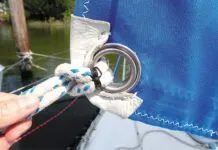Free-Wheeling Props
Your answer in the July 15 issue to the question about letting props free-wheel is fine, as far as it goes. How about other considerations, such as wear and tear on transmission bearings, noise, etc.? On our S-2 30 with a Yanmar 2GM engine, there is no noise that I can hear when the prop is turning, but I wonder about bearing wear. Does the answer vary depending on the specific brand or model of transmission? How do you know if you have a problem?
Bob Gillette
via email
The July 15 PS Advisor had to do with drag. The conclusion was that considerable reduction in drag is available if the prop, in the open, is allowed to free-wheel. If the prop is in an aperture, minimum drag is had by locking it vertically; the only problem is that you must remember to unlock the shaft when the prop is again called on for propulsion.
Reader Gillettes new question is about how much wear and tear there is on bearings and transmission when free-wheeling. Our sources say that there is, as one manufacturer said, less than negligible wear.
However, one veteran diesel expert told us that if you free-wheel on long passages, you should about every four hours start the engine, engage the transmission and take the engine up to operating temperature. Continue for 10 to 15 minutes. He said this will throw lubricants around in all the right places…and greatly prolong the life of the entire propulsion system.
Engaging is to lubricate the transmission.
Running 10 or 15 minutes at normal operating temperature is for the engine, and that should be a standard practice. If a diesel is started, it should be run long enough to thoroughly warm up, which takes 10 or 15 minutes after the cooling fluid shows normal. When finished with the engine, it should be idled for 10 or 15 minutes before shutting down. This permits the varying temperatures in the engine to stabilize.
These practices are not, of course, mandatory. They are simply good standard practices that will yield maximum service from one of the most expensive parts of your boat.
How Many Horsepower?
I need some advice concerning repowering a 1970 Ericson 35 MK-II. The original engine was an Atomic 4. I purchased a used 1984 Universal 18 diesel. I am wondering if I am a little lean in my choice? The engine has about 14 horsepower. The displacement of my boat is about 11,500 pounds-fairly light with a low wetted surface. What should be my overall engine horsepower? Will the Universal 18 do?
Jean Michel
Lyons New York
Fourteen horsepower seems a little lean. Tom Colvin, yacht designer and boatbuilder, might agree with you, however. He recommends 1 hp per long ton (2,240 lbs.) His idea is to use the engine only for powering into difficult anchorages and to recharge batteries. But it would be hard to find many people who actually do this.
Designer Ron Holland, on the other hand, recommends horsepower of four to six times displacement tonnage. So, between the two, you get recommendations of 5.1 hp and 30.6 hp. Certainly the recent trend has been to overpower boats, mostly because so many sailors motor so much of the time-when the wind is too light and when it is too strong. A large engine also may be required to run accessories such as refrigeration compressors and high output alternators. If your sailing style is otherwise, 14-18 hp may suffice.
Running Engine in Reverse
Your cruising editor-at-large, Nick Nicholson, suggests running his diesel in reverse for extended periods when charging batteries. My understanding is that the typical marine reverse gear is not designed for extended operation in reverse, something to do with the way the reverse gear is lubricated. Can you check this out?
David M. Blakemore
via email
Nick said he might do this at anchor, in order to place a light load on the diesel engine. Obviously one can’t put the engine in forward gear while at anchor. Placing a load on the engine is a good idea; idling a diesel (except for a brief warm-up and a 10- to 15-minute cooling down period) is not a good idea.
What about the transmission?
With a Velvet Drive (once made by Borg-Warner, but purchased about six years ago by Regal-Beloit), the answer is: Dont do it. Its not meant to go backwards for a long time.
On the other hand, Hurth said its gear boxes care not a whit about whether they are run in forward or reverse.
If you have some other make and intend to try what Nick suggests, youd best check the manual or give the manufacturer a call.



































